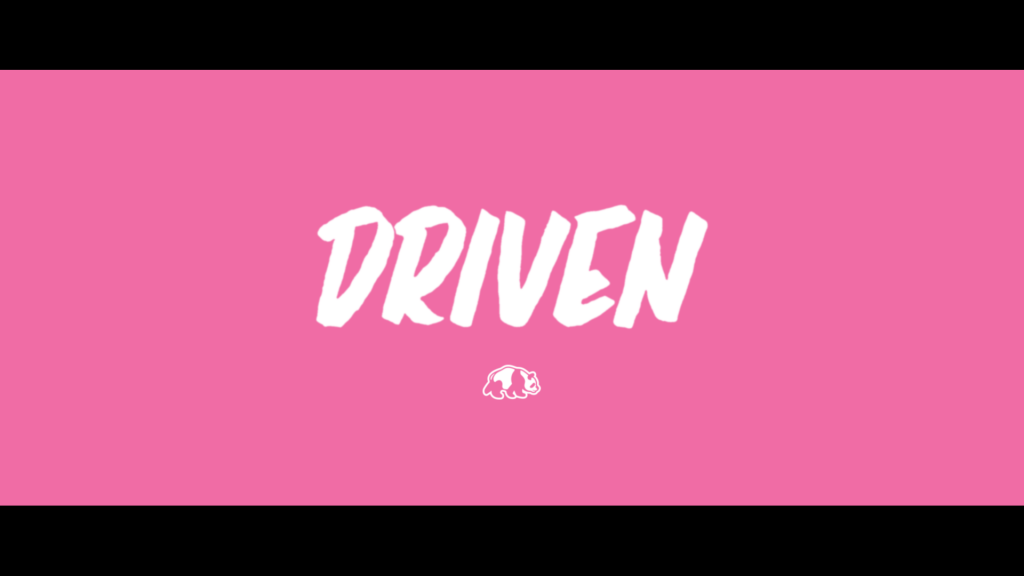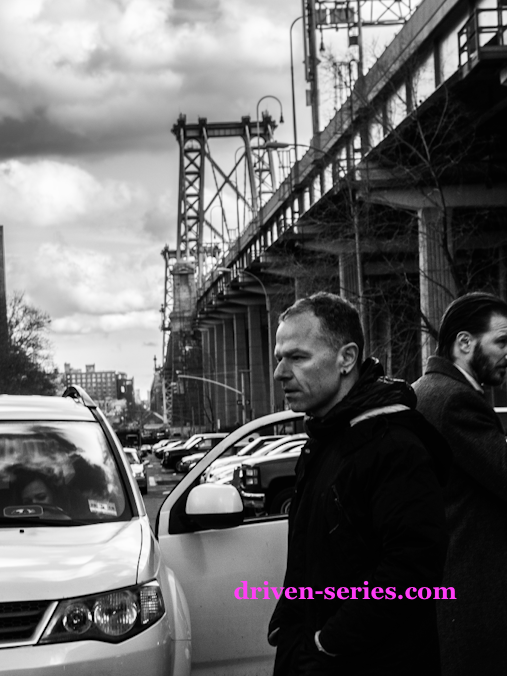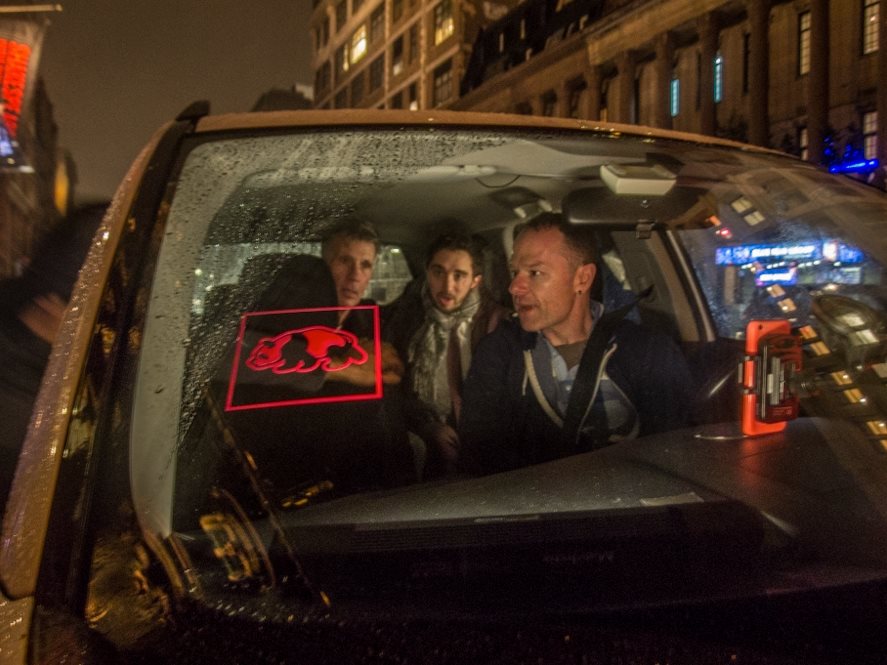INTERVIEW BY JENNIFER PARKER
–

“The key to life is figuring out how you’re fucked up, and rolling with it.” And Stephen Elliott should know. Elliott’s gone from The Adderall Diaries to his web series Driven to his latest book of essays, Sometimes I Think About It, which came out in November. The founder of The Rumpus is essentially a prolific artist. He’s taken the sum total of his life experiences and has made a web series that provokes, pokes and jabs us into being woke in a post-election climate that put us in a stupor, until #metoo illustrated how normalized bad behavior had become.
Driven co-presented by Slamdance is a fresh variation on pithy content in the age of information overload. It’s essentially the basis of self-reckoning as writer turned ex-writer and now a sort-of rival Uber-esque, Panda driver, Paul (Elliott) passively shepherds New York City’s wounded souls.
There’s something deeply profound about Driven, about the elegance of the quotidian and the banal of the interesting. It sort-of flips tropes. In the first episode – as in many debuts – he cleans his closet out and introduces himself: we learn that he is a writer – and relatively accomplished at this – when a fellow author, Michael Cunningham steps in, mentions no less than three times in earnest that he should consider writing for his new TV show his turning down of the offer possibly suggesting that this writer shopped a show in real life. We also learn that his girlfriend (Jennifer Missoni) is also living the life as a professional mistress, and that they haven’t had sex in a while (and although this is problematic for her, neither want to break-up, indicating either co-dependency, hope for the future or both. We also hear jokes about Williamsburg mentioned and Airbnb. Score two for the NYC bubble.
Like fellow gen-X author Bret Easton Ellis’ series, The Deleted, Driven also keeps its baroque moments off-camera to create an ominous tension, navigated by individuals reconciling difficult pasts. Our cabbie has his own troubled history, and in avoidance of the cabbie-sum-father confessor trope, his passengers are more mirrors of his mind-state than he is of theirs. Think Less Travis Bickle in Taxi Driver and more Willem Dafoe as John LeTour in Light Sleeper. Just go to Elliott’s website and look at a clip of The Adderall Diaries and you’ll see that he has a lifetime of agency to explore any broken aspect of our society.
Visually, Driven has the production values of a high budget, well-funded, scripted series. Elliott’s literary style ranges to a natural economy with pacing, framing and lighting. The first shot in episode three of Driven, comes from the perspective of a cat in a carrier watching the Panda car pulling up. Cut to Jorge (Brian Luna), the cat’s nervous looking owner in a superman hoodie who is not made any calmer by making conversation with his feline-allergic driver, Paul (Stephen Elliott). By the end of the episode, there will be a shared custody arrangement of a female cat named Bruce Wayne, a break-in, a delightful scene in a comic book store, a cat-napping and Elliott’s perfectly dry delivery of the statement, “dogs are loyal, cats don’t know who you are.”

The artistry onscreen of any episode of Driven is economy. Elliott tells a story with an arc in anywhere from eight to twelve minutes with production values that rival a major theatrical release, with each episode coming in for the impossible tight budget of $800.00. Anyone who is familiar with Elliott’s writing knows that he has a way of synthesizing complex information into clear and relatable language. His cross-genre memoir, The Adderall Diaries, has the tidiest explanation of a database kernel. Without a computer science degree, it is almost impossible to wrap your head around what the internal structures of a database engine actually is, which is funny considering data is what rules our lives online.
I had the chance to sit down with Stephen Elliott at Grumpy Café in Chelsea and by phone. We chatted over tea and pastries (I think I’m the only one who ate) to talk about his web series, Driven. It’s a rare interview, when all the interviewer needs to do is ask one question and the subject generously dictates the rest of the piece:
Jennifer Parker: What are you working on now?
Stephen Elliott: That is a good question. I think that the main thing I’m doing really is I’m working on the Driven web series. Making a few more episodes. Teaming up with Al Madrigal’s company, All Things Comedy. They host podcasts but now they’re going to start doing video content. They’re going to start hosting my web series and helping with the production and getting the word out as well. So, I’m pretty hopeful about that.
JP: I was struck by the cinematic quality of the production values. How did you manage to consistently produce what are tantamount to miniature movies?
SI: I don’t know. I mean I’m sure it is something to do with white privilege but. I just think that I was lucky that I worked with a lot of great people on other projects. And they liked working with me and I appreciated all the things they did. And I was able to convince these really amazing people to keep working with me on things that pay way below their rate. Like the guy that shot After Adderall (Adrian Correia) which is a $10,000 movie. He’s the cinematographer now for the second season of Glow, the Netflix’s show. So, this is a big-time guy who gets paid a lot of money, has a really coveted job amongst cinematographers, really well respected. Like most artists if he really likes the project, he’ll work on it.
There’s this thing about movie making that’s actually very Marxist. When the budgets get higher, everybody gets paid more and when the budget’s lower, everybody gets paid less, which is really beautiful actually. And great people work on really low budget stuff all the time. But you have to be able to convince them. They don’t want to work for really low pay on something that’s not going to be good. If they trust you and particularly if they like the script, then that’s most of it—really.
The other thing I think is it’s a lot easier to make a movie for no money than not enough money. People feel shortchanged when you don’t have enough money and they’re not going to give you their best. Because you’re only paying them not as much. But if there’s no money and everybody working on it is working on it because it’s an art project and they want it to be good and there’s an understanding that nobody’s going to make any money on it. We’re all doing this creative project. Like with Driven or like with after After Adderall, there was no chance of me ever making any real money off those things. I don’t even have contracts with anybody, I can’t sell these things; I can’t sell After Adderall to a distributor. I don’t have contracts for the people who work on it so everybody knows this person has no money, they’re really making an art project, something creative they care about and believe in—they want any part of that.
Whereas if you’re making something that’s a commercial project then and you’re really concerned with doing all the right paperwork and making sure that you can sell it and make money even if you don’t end up making money, but you leave that possibility open and you make people sign their lives away then of course they want to be paid more for that. I think it’s mostly finding good people and working with them over and over again. Also, when I write something that’s low budget. I write toward the budget but I don’t have any money so I try not to have more than two locations. And when I’m writing those locations, I’m writing places that I already know I can get. With a poem when you start, you have certain rules, like maybe 14 lines, and this many syllables, or whatever the rules are. Similarly, when I’m writing a script. If I know I have $500 to make this so I’m not going to put in something like a location that I don’t know that I can get that I don’t already have access to somehow.
JP: Happy Baby (Graywolf Press) was just reprinted in November. Congratulations. The first time we spoke you mentioned that this was the only book that you gave yourself a set of literary rules to follow when writing the book. How did that work?
SI: Yeah, I was really kind of like a literary fundamentalist. I’d really bought into this idea of show don’t tell. I’d been doing a workshop for the first time really in my life doing the Stegner Fellowship at Stanford. And so, I was with all these people that had done a lot of workshops because they all had MFA’s. They already considered themselves writers and they studied creative writing and then they either had an MFA or a Ph.D. in creative writing. I’d never studied creative writing before doing the Stegner Fellowship so with these people. I didn’t study for a long time and I’m learning a lot from them but I’m also realizing that. In workshops when people don’t know what to say they often say “why.” They want to know why this character is doing something. There is a real search for causation, and I realized that I really didn’t like that. I didn’t want to say why character was doing something because I don’t really think things. I don’t think most the things I do or don’t have one cause and effect. I did this because of that. All these different causes add up, we don’t really know why we do. I just blanked out. So, I had this rule that I was never going to tell you why, I was never going to answer the question of why. It only had “to.” The only thing that had it to be is it had to be true or it had to be possible. Is it conceivable that this character would do this? If it was conceivable and not impossible then I would never explain it. It’s enough that it’s possible that they do it.
There’s no backstory in Happy Baby and there’s no narration at all, the whole entire book is unseen. It always moves forward in the present tense even though each chapter is earlier than the one before it. I Had all these rules: No explaining, no narration, everything is seen you know. No adjectives, no adverbs, really lean and really fundamentalist. And the problem with that was it was great for that book. But then after that I got really stuck. You can’t you can’t write every book that way because you’re writing the same book over and over again. I didn’t know what to do after I’d written Happy Baby, I’m kind of written myself into a corner.
JP: In Driven and in Happy Baby and somewhat in The Adderall Diaries you incorporate BDSM so casually, it makes it almost commonplace.
SI: I don’t know if it is or it isn’t. It exists, it’s a thing. I think BDSM plays a role in a lot of people’s sex lives but there are so many different degrees of it. Like my entire sex life is BDSM. I don’t do anything else. I only do one thing and I’m 100 percent hardwired this way. Most people, their kinky stuff is just a plug in. it’s like your Safari browser and your browser is like just basic fucking and then you download the bondage plug in or the leather plug-in or the foot fetish plug-in and then you go from there, but for me, it’s the entire browser. So, I think I think power exchange is a huge part of sex for most people, but it’s just the amount or different degrees. So, in other words, in some ways it’s very niche, in other ways it’s very universal.
JP: Ok, that’s a great answer.
SI: People that are like me who are just really hard wired to only do kink, that’s actually pretty rare I think.
JP: Do you feel like there’s any parallels between Driven and any of your earlier work?
SI: Driven is kind of a way to get back into writing short stories. There’s consistent themes but ultimately, each one is an individual short story.

JP: What would you say are some of the consistent themes?
SI: Connection is a real big theme and. I’ve been writing a lot about love and the impossibility of love. So those are some basic things but also almost every episode is a commentary on the new political landscape. It’s very subtle, but most characters are dealing with something that they weren’t dealing with before Trump was elected if that makes any sense. They’re funny but they’re quite a bit more political than they may seem at first blush.
It’s a lot about connection. I’ve been working on this novel and there’s this character in the novel who realizes he’s incapable of love. And I’m kind of obsessed with that idea. I just want to explore that and write about what that means.
JP: Do you think that people are incapable of love or do you think we fool ourselves into thinking we are capable of it?
SI: I think the main thing is that every single person has a different definition of love. There’s no wrong definition there’s no wrong reason to love somebody. I think people get disappointed a lot because we love someone whose definition of love might be different from ours. Because that’s a very normal thing to have happen, really people radically diverge in what they think love is. The two main characters in a novel, that’s kind of one of the biggest conflicts. Diametrically opposed definitions of love. To one of them you know love comes and goes. It’s not it’s not something safe. If you fall out of love with somebody then it means you never did love them. It’s impossible. Love is a permanent state of flux. And. You can see through accomplishing two characters that marry such radically different ideas of what love is.
JP: Anything else you want to touch on?
SI: I have four episodes of Driven in post. One is based on the Martin Scorsese cameo from Taxi Driver, except played by Madeline Xima as a young lesbian. There’s also the immigration episode, starring Sakina Jaffrey and Al Madrigal. So many car share drivers are immigrants so that episode is particularly relevant.
Catch Driven on the Slamdance website http://slamdance.com/Slamdance-Co-Presents-New-Web-Series-by-Stephen-Elliott-DRIVEN and on Stephen Elliott’s website http://www.stephenelliott.com/. Elliott is generous with his content and makes it available for free.
__
Jennifer Parker is a Manhattan-based writer and mother. The editor in chief of StatoRec, Jennifer’s film criticism and author profiles have appeared in Fjords Review and the Los Angeles Review of Books.
![[PANK]](https://pankmagazine.com/wp-content/themes/pank/assets/images/pank-logo-large.png)
